Joost was an internet TV service startup founded by Janus Friis and Niklas Zennström, the creators of Skype and Kazaa. Joost was originally known as "The Venice Project" during its development phase. Initially, it offers a peer-to-peer (P2P) internet television service that aimed to revolutionize the way people consumed digital media content, and then switched to a web version offering online streaming content.
The platform was launched in 2007 and offered users access to TV shows, movies, and other video content, via its desktop client software. Joost leveraged the P2P technology to distribute content, which was expected to provide better scalability and cost-effectiveness for delivering videos to a large audience.
Official Website: joost.com
Founded: 2006 (Officially released in 2007)
Founders: Niklas Zennström and Janus Friis
Headquarters and subsidiaries: Holland, US and UK
Acquired by: Adconion in 2009
Discontinued: 2012
Despite its innovative approach and substantial financial backing, Joost faced challenges in gaining widespread traction in the rapidly evolving online video streaming landscape. It encountered competition from other streaming services like YouTube and Hulu. As the broadband internet improved and adoption of high-efficiency video codecs, the P2P approach became obsolete.
As a result, Joost's popularity dwindled, and it struggled to compete with other streaming giants. Eventually, in 2008, Joost discontinued its P2P service and transitioned to a Flash-based online video site. In 2012, the remnants of Joost were acquired by Adconion Media Group.
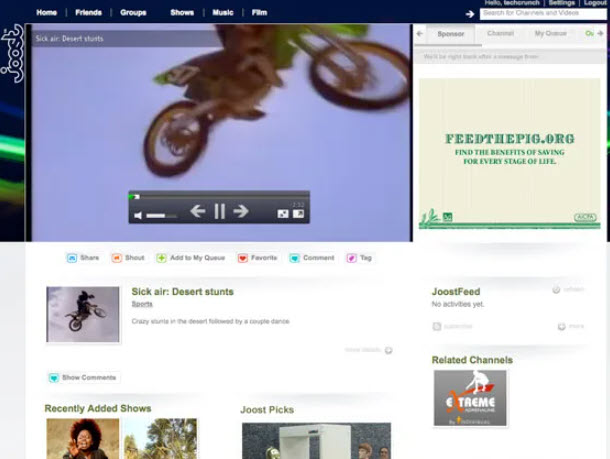
What happened to Joost, the once-promising trailblazer that attracted press hype even before its official release? In this blog, we delve into the rise, the hurdles faced, and the ultimate fate of this trailblazing platform. Join us as we uncover the story of Joost.
The History of Joost
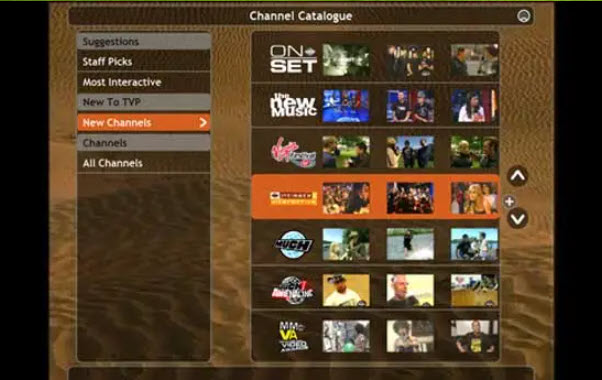
The Venice Project Launched as Joost
Initially, Joost was developing under the code name "The Venice Project" in 2006, mainly focusing on the P2P online television service devoid of user-generated content. Even before its official launch, the project gained considerable attention due to the founders' reputation, established through successful ventures like Skype and Kazaa.
The founder's vision for the Venice Project was to "merge the best of TV and the best of the Internet", as observed by Friis, who wrote on his blog that they had "just taken a big step on a long journey".
On January 17, 2007, the project was launched as Joost - still in its beta stage - headquartered in Dutch, owned by Oak Grove Corporation in Curacao.
Joost Partnered with Content Copyright Holders and TV Networks
Joost leveraged its high-profile founders to secure advantageous partnerships with content copyright holders and major TV networks. In 2007, Joost signed deals with Viacom, allowing users to enjoy content from MTV, Comedy Central, and Nickelodeon. Joost was benefited from the Viacom-YouTube dispute, where Viacom had ordered Google to take down more than 100,000 allegedly copyrighted videos from YouTube. The deal signified Viacom's willingness to work with online distributors that protect their copyright.
Further collaborations followed. On May 1, 2007, Joost partnered with the Turner Broadcasting System. Users of the Joost desktop client were able to access content from Adult Swim, CNN, Hasbro, the NHL, Sony Pictures Television and Sports Illustrated. There were also popular content featuring Hasbro, TRANSFORMERS channel and G.I. JOE channel.
On May 8, 2007, Joost scored the deal with Warner Bros, offering content from SCI-FI FIX and WBTV. Users were able to access the Adventures of Briscoe County, Aquaman, Babylon 5, Crusade, Human Target, Invasion, Max Headroom, My Favorite Martian, etc.
Later in July 10, 2007, Joost also landed the deal with Major VH1. The latter allowed Joost to offer its new series "I Hete My 30s" before it even released TVs – a full 10 days ahead, around the States.
Additionally, Joost also sought partnership outside the US. In October, 2007, Joost planned to feature AniBoom's channel. AniBoom was a Isreali animation startup, boasting 3,000 animators around the world with 30k videos. They reached an agreement to split the revenue among AniBoom, Joost, and the animators.
Joost Received $45 Million Funding
In a venture round of financing on May 10, 2007, Joost secured a substantial $45 million funding from Sequoia, Index, CBS, Viacom, and Chinese billionaire Li Ka-shing. Interestingly, Sequoia, also an investor in YouTube, was indirectly competing with Joost at the time.
In July 25, 2007, at a press event in Estonia, Zennström revealed that Joost had amassed over one million beta testers. At that time, Joost remained as a desktop client which required users to download to use.
In October 2, 2007, public beta 1.0 of Joost was unveiled, available to be downloaded on its blog.
Challenges and Transformations
Challenges from Competitors and Imitators
In 2007, even before Joost was officially released, the online TV tech startup found itself surrounded by rivals and imitators.
In September, 2007, HP launched Next.TV, a P2P IPTV system pre-installed in HP notebooks. Next.TV was powered by Dave Networks, a white label IPTV provider. The platform featured content from prominent networks like CBS, Freemantle, Endemol, MGM, eye.tv, Lazy.tv, and Reality.tv.
Another competitor, Miro Media Player, was announced in November, 2007. It is open-sourced, DRM-free, and were directly connected to YouTube and blip.tv. Offering HD content and supporting BitTorrent, Miro posed a significant threat to Joost, which was DRM-protected and excluded video sharing sites.
Active in 2007, WiTV, short for Wireless Internet TV, also posed threats to Joost. Though WiTV was not a P2P service, it runs with a central server for everybody. Users can access content just as they did with Joost, BabelGum and WeohTV, but via a web browser.
Adding to the challenge, Joost clones further complicated the landscape. There was a Paul Yanez's version of Joost clone, which imitates the look and feel of Joost. While Joost is a desktop program, the clone version was available through a Flash interface through the web browser, appealing to users who preferred not to download a desktop program. Another copycat was called DNAStream, operated as a business without mentioning Joost at all.
Given the founders' previous experience with the litigation turmoil of Kazaa from 2001 to 2006, taking legal action against these programs was probably the last thing Joost's founders would love to do.
Challenges from New Video Codecs and Streaming Tech
While Joost stuck to its P2P IPTV tech - distributing content through the desktop client, web streaming services from its rivals continued to grow. Adobe's release of Flash Player 9, incorporating the H264 codec, improved visual quality without compromising bandwidth speed, a key factor for YouTube's streaming success.
Competitors like Brightcove began offering full-screen, TV-quality video streams via BitTorrent DNA, challenging Joost's position. Besides visual quality and connection speed, the content versatility and distributing algorithm also became crucial. According to a report from Techcrunch, the view experience in Joost was not ideal, as users may need to sift through tons of unwanted video to find unique content.
Joost never stopped adding new content and stimulating user engagement, though. In November 2007, Joost integrated Meebo's chat feature, enabling instant messaging within Joost. In January, 2008, it teamed up with the Indie music and film site OurStage to offer "user picked content": Best of OurStage Shorts, Best of OurStage Comedy, OurStage Music Videos, and OurStage Artist Access.
Joost's Turmoil and Restructuring
On January 17, 2008, Joost fired its CTO Dirk-Willem van Gulik, who then joined BBC as the chief technical architect of the BBC Future Media and Technology Group. This group was actively developing the iPlayer online TV project, which could be seen as an alternative to Joost to some extent.
In the same year, in April, Joost made a strategic decision to shift its focus solely to the US market, abandoning its global ambitions. This move resulted in a significant restructuring of its staff.
The New Joost: Web Version
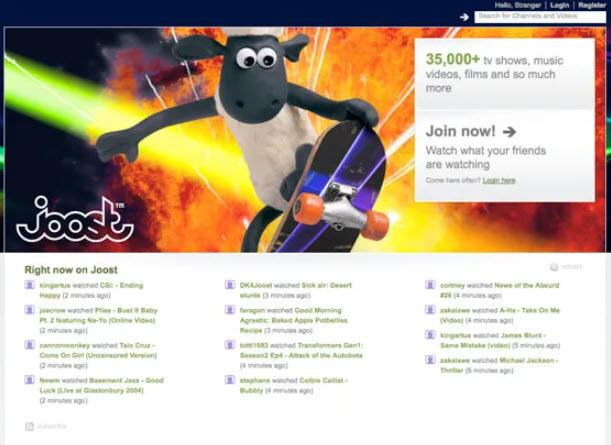
On September 18, 2008, Joost launched its web version, new.joost.com, though it still required users to install a plug-in to use the PSP technology. One month later, on October 14, Joost went 100% Flash, no plug-in was needed.
Besides changing the way of distributing content, Joost also aimed to create a video-based social network. For instance, the web version features activity streams of users' friends, watch history, and comments, which resembled the Facebook style.
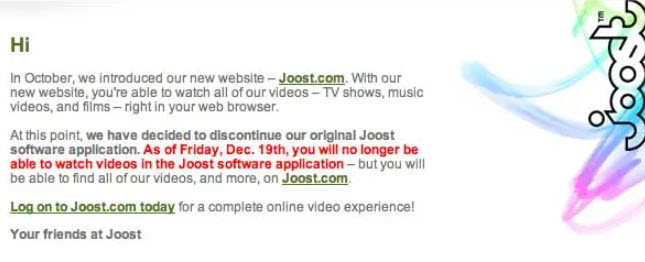
On December 18, 2008, Joost gave up on P2P completely. The P2P file-sharing technology used to be promising, and had witnessed the popularity of Niklas Zennström and Janus Friis' PSP startup project Kazaa in the early 2000s. But the market was proved to be promising by offering web content, instead of urging users to download a desktop client.
Still, it's hard for Joost to compete in the already crowded lineup of offerings from Hulu, Amazon, YouTube, and DailyMotion. It seemed Joost had lost its competing edge in the advancement of streaming tech and new video codecs. Unique content and viewing experience are other contributing factors.
On November 30, 2008, Joost released their iPhone App. Micheal Arrington, an editor from TechCrunch tested the app and found it was less smooth than YouTube videos, which provided a much more seamless experience in terms of network quality.
After switching to the Web Flash version, and giving up on P2P, Joost experienced a spike in web traffic. As shown in the graph from Compete and comScore, the viewership rocketed in November 2008.
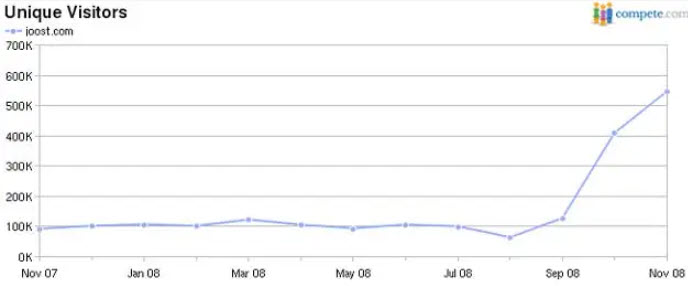
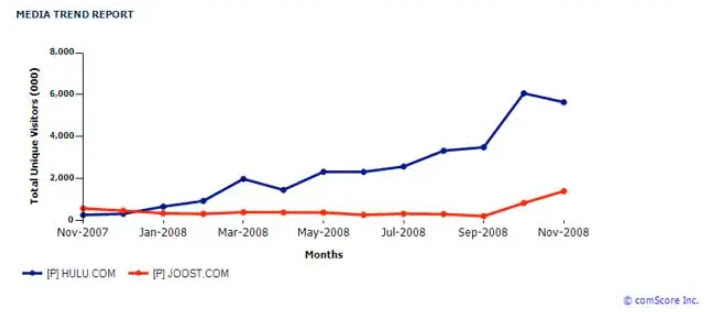
Next year, in March 2009, Joost worked with Netlog to expand user reach in Europe. Netlog is a Belgium-based social networking service, boasting 40 million users. The deal was to incorporate Joost's video library into the starting page of Netlog, where users can view and share 57,000+ TV shows and music videos.
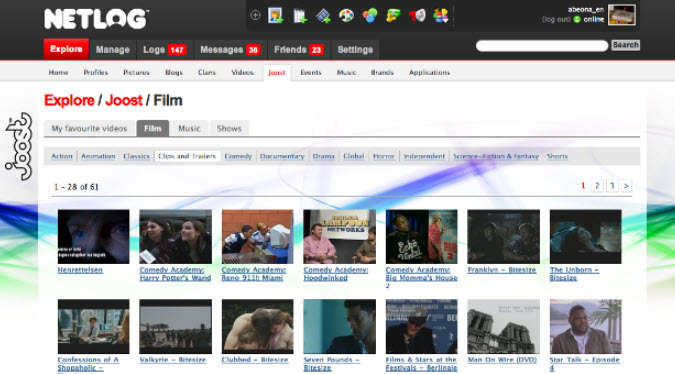
Another Round of Internal Turmoil
On July 1, 2009, Joost's CEO Mike Volpi stepped down, and the company is laying off a significant portion of its staff. Meanwhile, Joost decided to steer away from its existing business model, choosing to refocus the service as a "white label online video platform for media companies."
Subsequently, on September 18, 2009, Joost filed a lawsuit against its former CEO, Mike Volpi, with Index Ventures, the VC firm where Volpi worked as a partner, also involved in the suit. The founders, Friis and Zennström, accused Volpi of leaking trade secrets from Joost.
Amidst Joost's uncertain future, Friis and Zennström embarked on another entrepreneurial venture, Rdio, an online music streaming service.
What Then Happened to Joost
In early October 2009, the UK subsidiary of Joost went into liquidation. A month later, on November 24, key assets from Joost were acquired by Adconion Media Group. The acquisition aligned with Adconion's "white-label video platform" strategy, as the media group had recently partnered with the Goldbach Media Group to provide a display video ad-serving solution. Joost.com continued to operate during this period.
The final blow came on May 9, 2012, when Adconion rebranded and integrated Joost Media into smartclip, a video advertising company that Adconion had acquired in November 2011.







